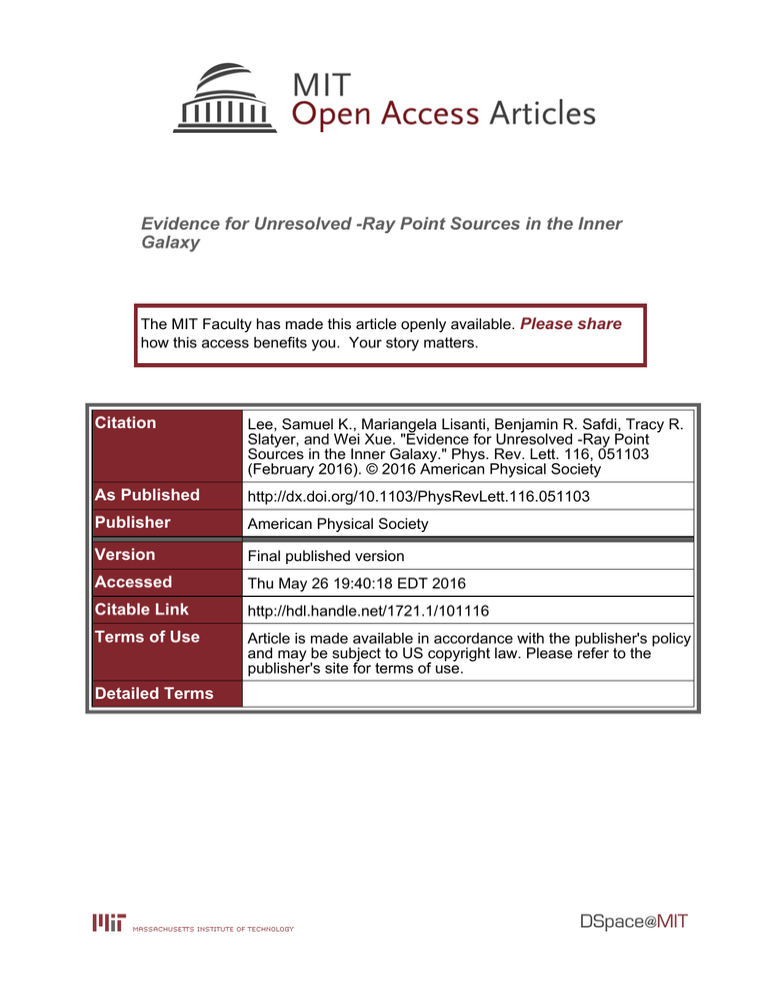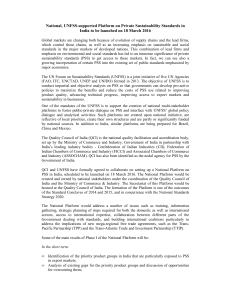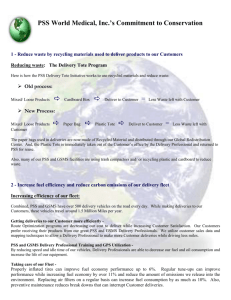Evidence for Unresolved -Ray Point Sources in the Inner Galaxy Please share
advertisement

Evidence for Unresolved -Ray Point Sources in the Inner Galaxy The MIT Faculty has made this article openly available. Please share how this access benefits you. Your story matters. Citation Lee, Samuel K., Mariangela Lisanti, Benjamin R. Safdi, Tracy R. Slatyer, and Wei Xue. "Evidence for Unresolved -Ray Point Sources in the Inner Galaxy." Phys. Rev. Lett. 116, 051103 (February 2016). © 2016 American Physical Society As Published http://dx.doi.org/10.1103/PhysRevLett.116.051103 Publisher American Physical Society Version Final published version Accessed Thu May 26 19:40:18 EDT 2016 Citable Link http://hdl.handle.net/1721.1/101116 Terms of Use Article is made available in accordance with the publisher's policy and may be subject to US copyright law. Please refer to the publisher's site for terms of use. Detailed Terms PRL 116, 051103 (2016) week ending 5 FEBRUARY 2016 PHYSICAL REVIEW LETTERS Evidence for Unresolved γ-Ray Point Sources in the Inner Galaxy Samuel K. Lee,1,2 Mariangela Lisanti,3 Benjamin R. Safdi,4 Tracy R. Slatyer,4 and Wei Xue4 1 Princeton Center for Theoretical Science, Princeton University, Princeton, New Jersey 08544, USA 2 Broad Institute, Cambridge, Massachusetts 02142, USA 3 Department of Physics, Princeton University, Princeton, New Jersey 08544, USA 4 Center for Theoretical Physics, Massachusetts Institute of Technology, Cambridge, Massachusetts 02139, USA (Received 24 July 2015; revised manuscript received 3 November 2015; published 4 February 2016) We present a new method to characterize unresolved point sources (PSs) generalizing traditional template fits to account for non-Poissonian photon statistics. We apply this method to Fermi Large Area Telescope γ-ray data to characterize PS populations at high latitudes and in the Inner Galaxy. We find that PSs (resolved and unresolved) account for ∼50% of the total extragalactic γ-ray background in the energy range ∼1.9 to 11.9 GeV. Within 10° of the Galactic Center with jbj ≥ 2°, we find that ∼5%–10% of the flux can be accounted for by a population of unresolved PSs distributed consistently with the observed ∼GeV γ-ray excess in this region. The excess is fully absorbed by such a population, in preference to dark-matter annihilation. The inferred source population is dominated by near-threshold sources, which may be detectable in future searches. DOI: 10.1103/PhysRevLett.116.051103 Dark-matter (DM) annihilation in the Galactic halo can contribute to the flux of high-energy γ rays detected by experiments such as the Fermi Large Area Telescope (LAT) [1]. Currently, an excess of ∼GeV γ rays has been observed by the Fermi LAT near the Galactic Center (GC) [2–16]. The signal extends ∼10° off the plane, is approximately spherically symmetric, and has an intensity profile that falls as r−2γ with γ ≈ 1.1–1.4 [12,14]. The morphology and energy spectrum of the signal is consistent with DM annihilation. There is some possible tension between the DM interpretation and other searches, especially in dwarf galaxies [17]; alternate explanations include a new population of millisecond pulsars (MSPs) [11,18–26] or cosmic-ray injection [27,28]. This Letter addresses the potential contribution of unresolved point sources (PSs) to the excess through the use of a new statistical method called a non-Poissonian template fit (NPTF). Our approach is model independent, in that we remain agnostic about the nature of the PSs. To verify the method, we use it to characterize unresolved γ-ray PSs at high Galactic latitudes. These findings represent one of the most precise measurements of the contribution of PSs to the extragalactic γ-ray background (EGB) and have important implications for characterizing its source components. The main focus of this Letter is to use the NPTF to search for a population of unresolved γ-ray PSs in the Inner Galaxy (IG) with a morphology consistent with that of the excess. We find that the NPTF strongly prefers a PS origin for the excess over a DM-like (smooth diffuse) origin. The Supplemental Material [29] provides further details on the method, as well as additional cross-checks that support these conclusions. 0031-9007=16=116(5)=051103(6) This study analyzes the Extended Pass 7 Reprocessed Fermi-LAT data from ∼August 4, 2008 to ∼December 5, 2013 made available by Ref. [33]. A HEALPix [34] pixelization of the data with nside ¼ 128 is used, corresponding to pixels ∼0.5° to a side. We emphasize that our study focuses on data in a single energy bin from 1.893 to 11.943 GeV and does not rely on or extract spectral information for the excess. The choice of this energy range keeps the signal-to-background ratio in the region of interest (ROI) high, maintains a sufficiently large number of photons over the full sky, and keeps the point-spread function relatively small and energy independent. The analysis utilizes the photon-count probability distribution in each pixel. In general, a given model for the ðpÞ γ-ray flux with parameters θ predicts a probability pk ðθÞ of observing k photons in a pixel p. Several source components, each modeled by a spatial template, can contribute photons in a pixel. To date, analyses using templates have assumed Poisson statistics for the photonðpÞ count distribution—specifically, that pk ðθÞ is the Poisson probability to draw k counts with mean given by the sum of the template components in pixel p. To account for unresolved PSs, the standard templatefitting procedure must be generalized to include nonPoissonian photon counts. In the NPTF procedure, ðpÞ pk ðθÞ depends on a potentially pixel-dependent PS source-count function dN p =dF. The source-count function determines the average number of PSs within pixel p that contribute photon flux between F and F þ dF. In this work, the source-count function is assumed to follow a broken power law, dN p =dF ∝ Ap F−n , with pixeldependent normalization Ap and indices n1 (n2 ) above (below) the break Fb that are constant between pixels. For 051103-1 © 2016 American Physical Society PRL 116, 051103 (2016) PHYSICAL REVIEW LETTERS isotropically distributed PSs, Ap is constant between pixels. To model a population of PSs that mimics a DM annihilation signal, Ap must instead follow the DM annihilation ðpÞ template. Semianalytic methods for calculating the pk ðθÞ with a broken power-law source-count function were developed in Refs. [35,36]. We include templates for up to seven different components in the NPTF analysis: (1) diffuse background, assuming the Fermi-LAT p6v11 diffuse model, (2) Fermi bubbles, assuming uniform emission within the bubbles [37], (3) isotropic background, (4) annihilation of NavarroFrenk-White- (NFW-) [38,39] distributed DM, assuming no substructure, (5) isotropic PSs, (6) disk-correlated PSs, and (7) NFW-distributed PSs. (More specifically, the 2D spatial distribution of flux from the PSs projected along the line of sight follows the flux distribution of γ rays from DM annihilation, assuming the DM is distributed with a generalized NFW distribution.) Templates (1)–(4) are specified by a single normalization parameter each. Templates (4) and (7) assume a generalized NFW distribution with inner slope γ ¼ 1.25. Template (6) corresponds to a doubly exponential thin-disk source distribution with scale height 0.3 kpc and radius 5 kpc. The PS templates each have four parameters describing their respective source-count functions. Bayesian methods (implemented with MultiNest [40,41]) are used to extract posterior distributions for the model parameters. The prior distributions of all parameters are flat, except for those of the DM and PS normalization factors, which are log flat. Unless otherwise stated, the prior ranges of all parameters are sufficiently large so that the posterior distribution is well converged. We begin by applying the NPTF to data at high Galactic latitudes (jbj ≥ 30°). The 3FGL [42] identifies 1307 γ-ray PSs in this region of the sky, with ∼55% associated with active Galactic nuclei and ∼24% associated with pulsars, supernova remnants, and other known γ-ray sources. The remaining ∼21% are unassociated. Figure 1 shows the source-count function dN=dF in terms of the flux of the 3FGL PSs in our energy bin (black points). The observed source-count function is suppressed below F ∼ 10−10 photons=cm2 s, where it is hard to detect PSs over the diffuse background with the current exposure. The NPTF is performed in this high-latitude region, including templates for the diffuse background, Fermi bubbles, isotropic emission, and isotropic PSs. The best-fit source-count function values are given in Table I. (The exposure map in Ref. [33], with average exposure ϵav ¼ 4.45 × 1010 cm2 s, is used to translate between the number of photons S and the flux F.) The pointwise 68% confidence interval for the source-count function is shown in Fig. 1, shaded green. The source-count function matches the 3FGL data well above F ∼ 10−10 photons=cm2 s. The best-fit intensities obtained from the NPTF can be compared to those obtained from a standard template fit that neglects PSs. The diffuse background and week ending 5 FEBRUARY 2016 FIG. 1. The source-count function for high-latitude point sources derived from applying non-Poissonian template fits to data with third Fermi-LAT catalog (3FGL) sources [42] unmasked (green band) and masked (orange band). The colored bands indicate 68% confidence intervals, which are computed pointwise in F from the posteriors for the source-count-function parameters, while the solid and dashed black lines show the median source-count functions. The black points show the source-count function of the detected point sources in the 3FGL. The vertical error bars indicate 68% confidence intervals; the horizontal bars denote bins in F. Fermi-bubble intensities (averaged over the ROI) are consistent between both procedures. When the PS template is included, the isotropic-background intensity is I iso ¼ −7 1.38þ0.07 photons=cm2 s sr, and the isotropic PS −0.07 × 10 þ0.08 −7 photons=cm2 s sr. intensity, it is I iso PS ¼ 1.67−0.09 × 10 With no PS template, the isotropic-background intensity −7 2 is over twice as high, I iso ¼3.00þ0.03 −0.03 ×10 photons=cm ssr. Thus, the PS intensity is absorbed by the isotropicbackground template in the standard procedure. The averaged intensity of the observed 3FGL PSs is ∼9.32 × 10−8 photons=cm2 s sr at high latitudes. Using the result of the NPTF described above and neglecting systematic uncertainties in modeling the 3FGL PSs, we predict that the intensity of unresolved PSs is −8 7.38þ0.83 photons=cm2 s sr. This can be checked −0.85 × 10 explicitly by repeating the NPTF with all 3FGL PSs masked (at an ∼1° radius). The results of this fit are given in Table I and illustrated by the orange band in Fig. 1. The source-count function for the unresolved PSs agrees with that computed from the unmasked sky at low flux. This suggests that the NPTF is sensitive to contributions from unresolved PSs below Fermi LAT’s detection threshold. The intensity of the isotropic background is −7 I iso ¼ 1.55þ0.07 photons=cm2 s sr, which agrees −0.07 × 10 with that from the 3FGL unmasked NPTF, within uncertainties. The intensity of the isotropic PSs is I iso PS ¼ −8 2 4.61þ0.72 × 10 photons=cm s sr, which is slightly lower −0.88 than the value inferred from the 3FGL unmasked NPTF. I iso corresponds to the intensity of the isotropic γ-ray background, while I iso þ I iso PS gives the intensity of the EGB. While the PS template does absorb some contribution from Galactic PSs, extragalactic PSs are expected to 051103-2 week ending 5 FEBRUARY 2016 PHYSICAL REVIEW LETTERS PRL 116, 051103 (2016) TABLE I. Best-fit values (16th, 50th, and 84th percentiles) for the source-count functions associated with the PS templates in the highlatitude (HL) and Inner Galaxy (IG) ROIs. The source-count function is fit by a broken power law, where n1ð2Þ is the slope above (below) the break in dN=dF given by Fb. The source-count function for the isotropic PS component in the IG is not included, as its flux fraction is subdominant. Depending on the analysis, the Fermi-LAT 3FGL sources may either be masked or unmasked. Where appropriate, we provide the Bayes factor in preference for including the NFW PS component, in both the real data and in simulations, as well as the constraint on the flux fraction (calculated as in Fig. 2) attributed to NFW DM. ROI Template HL Iso. PS IG NFW PS þ disk PS IG NFW PS þ disk PS 3FGL n1 unmasked 3.98þ2.72 −0.72 masked 4.06þ0.40 −0.29 n2 Fb (photons=cm2 s) 1.82þ0.01 −0.02 1.56þ0.12 −0.16 −9 9.05þ5.68 −2.06 × 10 þ1.40 −12 3.72−0.71 × 10 Bayes factor Bayes factor NFW DM (data) (simulation) (95% confidence) þ0.98 þ0.44 −10 unmasked 18.2þ8.44 −7.91 −0.66−0.90 1.76−0.35 × 10 þ8.19 þ0.12 þ1.92 17.5−8.40 1.40−0.15 6.80−1.25 × 10−9 ∼106 ∼105 <0.44% þ1.07 þ0.45 −10 18.5þ7.78 −8.09 −0.73−0.83 1.62−0.32 × 10 þ1.24 þ9.24 þ8.85 17.0−8.68 −0.21−1.18 6.58−4.36 × 10−10 ∼102 ∼102 <0.48% masked dominate. From the 3FGL unmasked NPTF, we infer that 55þ2 −2 % of the EGB in this energy range is associated with both resolved and unresolved PS emission; from the 3FGL masked NPTF and using the intensities of the 3FGL PSs, we find that 47þ2 −2 % of the EGB is due to PS emission. These estimates appear to be consistent with those in Refs. [35,43], though a direct comparison is made difficult by the fact that these analyses cover a different energy range and only use the first ∼11 months of Fermi-LAT data. Our estimates for I iso agree with the most recently published results from Fermi LAT [44]. Next, we use the NPTF procedure to determine the fraction of flux from unresolved PSs in the IG. These analyses include templates for the diffuse background, the Fermi bubbles, isotropic background, and NFW-distributed DM, in addition to isotropic, disk-correlated, and NFW-distributed PSs. While the prior ranges for the isotropic, isotropic PS, Fermi bubbles, and diffuse background template parameters are not constrained by the high-latitude fit, restricting these parameters to their highlatitude values does not significantly affect the results. (In particular, allowing the isotropic and isotropic PS template parameters to float allows the isotropic components to partly compensate for flaws in the other templates. Mismodeling that is roughly uniform across the relatively small IG ROI can be absorbed in this way. For example, if our disk-correlated PS template is more sharply peaked toward the Galactic plane than the true disk PS population, the isotropic PS template can pick up an additional positive contribution that absorbs the higher-latitude disk PSs. If our disk PS template is broader in latitude than the true disk PS population, a negative contribution to the isotropic PS template can help account for this. Thus, the “isotropic” templates in the IG may, in principle, be either brighter or fainter than their high-latitude counterparts.) The ROI consists of all pixels within 30° of the GC with jbj ≥ 2°, masking out the plane. As above, we perform two analyses, one on the full ROI and another with all 3FGL PSs masked. For both cases, the source-count functions and flux fractions are quoted with respect to the region within 10° of the GC and jbj ≥ 2°, with no PSs masked. The source-count function of the Galactic and unassociated 3FGL PSs in the IG is given by the black points in the left panel of Fig. 2, with the number of PSs in each bin indicated. The majority (∼90%) of these PSs are unassociated. Consider, first, the case where the 3FGL sources in the IG are unmasked. The left panel of Fig. 2 shows the best-fit source-count function for the NFW PS (dashed, orange), isotropic PS (dotted, green), and disk PS (solid, blue) populations. The disk-correlated PS template accounts for the high-flux 3FGL sources. Below F ∼ 2 × 10−10 photons=cm2 s, the NFW PS template accounts for nearly all the PS emission; its source-count function has a steep cutoff just below the source sensitivity threshold. It is worth noting that there is no externally imposed threshold for the PS population in this case, as the 3FGL sources are not masked. The most pressing question to address is whether the excess flux in the IG is better absorbed by the NFW PS or NFW DM template. The right panel of Fig. 2 shows the respective flux fractions computed relative to the total photon count in the inner 10° region with jbj ≥ 2° and the 3FGL sources unmasked. The disk and isotropic PSs þ0.5 contribute 5.3þ0.9 −0.9 % and 1.1−0.4 % of the flux, respectively. In contrast, the best-fit flux fraction for the NFW PS component is 8.7þ0.9 −0.8 %, while the best-fit DM flux fraction is consistent with zero. The normalization of the diffuse model remains consistent (to within 1%) with expectations from the fit at high latitudes, suggesting that the NFW PS template is absorbing the excess, and only the excess, and corresponds to a source population distinct from the more disklike population of resolved sources. When the NFW PS template is omitted (inset), the fraction of flux absorbed by the disk PS population is essentially unchanged at þ0.7 6.8þ0.7 −0.9 %, and the DM template absorbs 7.7−0.8 % of the flux. The DM flux obtained in absence of a NFW PS 051103-3 PRL 116, 051103 (2016) PHYSICAL REVIEW LETTERS week ending 5 FEBRUARY 2016 FIG. 2. (Left) Best-fit source-count functions within 10° of the GC and jbj ≥ 2°, with the 3FGL sources unmasked. The median and 68% confidence intervals are shown for each of the following PS components: NFW (dashed, orange), thin disk (solid, blue), and isotropic (dotted, green). The number of observed 3FGL sources in each bin is indicated. The normalization for the diffuse emission in the fit is consistent with that at high latitudes, as desired. (Right) Posteriors for the flux fraction within 10° of the GC with jbj ≥ 2° arising from the separate PS components, with 3FGL sources unmasked. The inset shows the result of removing the NFW PS template from the fit. Dashed vertical lines indicate the 16th, 50th, and 84th percentiles. template is consistent with other estimates in the literature [12,14]. The model including the NFW PS contribution is preferred over that without by a Bayes factor ∼106 (for reference, this corresponds to test statistic 2Δ ln L ≈ 36). When the 3FGL sources are masked, the NPTF procedure yields a best-fit source-count function given by the orange band in the left panel of Fig. 3. Below the break, the source-count function agrees well with that found by the unmasked fit. In this case, the contributions from the isotropic and disk-correlated PS templates are negligible. The flux fraction attributed to the NFW PS component is 5.3þ1.0 −1.1 %, while the NFW DM template absorbs no significant flux. In the masked analysis, the Bayes factor for a model that contains a NFW PS component, relative to one that does not, is ∼102 , substantially reduced relative to the result for the unmasked case. Masking the 3FGL sources removes most of the ROI within ∼5° of the GC, reducing photon statistics markedly, especially for any signal peaked at the GC. Furthermore, in the masked ROI, non-NFW PS templates can absorb a substantial fraction of the excess. For example, if only disk and isotropic PS templates are added, the flux fraction attributed to the disk template is þ1.6 2.5þ0.70 −0.62 %, while that attributed to NFW DM is 2.2−2.2 % (the flux attributed to isotropic PSs is negligible). When no PS templates are included in the fit, the NFW DM template absorbs 4.1þ1.1 −1.2 % of the total flux. As we will discuss later, this behavior agrees with expectations from simulated data. In this statistics-limited regime, the fit does not distinguish different models for the PS distribution at high significance (however, if we repeat the analysis using Pass 8 data up to June 3, 2015, corresponding to an average exposure increase of ∼30% and a slight improvement in angular resolution, the Bayes factor in favor of NFW PSs increases from ∼102 to ∼104 in the 3FGL masked analysis; in the 3FGL unmasked analysis, the Bayes factor in favor of NFW PSs increases from ∼106 to ∼109 ), but there is still a strong preference for unresolved PSs. The Bayes factor for a model with disk and isotropic PSs, relative to one with no PSs, is ∼106 , while the Bayes factor for a model with NFW, disk, and isotropic PSs, relative to one with no PSs, is ∼108 . The Bayes factors, best-fit source-count function parameters, and DM flux fractions for the 3FGL masked and unmasked analyses are summarized in Table I. To validate the analysis procedure, we generate simulated data using the best-fit parameters from the unmasked IG FIG. 3. Same as Fig. 2, except with 3FGL sources masked. 051103-4 PRL 116, 051103 (2016) PHYSICAL REVIEW LETTERS week ending 5 FEBRUARY 2016 FIG. 4. Results obtained by applying the NPTF to simulated data. (Left column) The source-count functions for the PS templates in the fit when NFW PSs are included in the simulated data (top) or not (bottom). Note that when NFW PSs are not simulated, a NFW DM component is instead. (Right column) The associated posteriors for the fraction of flux absorbed by the different templates in the fit. The inset plots show the results of analyzing the simulated data without a NFW PS template in the fit. All plots are relative to the region within 10° of the GC with jbj ≥ 2° and 3FGL sources unmasked. For the flux-fraction plots, the fractions are computed relative to the total number of counts observed in the real data. analysis; we include isotropic, Fermi bubbles, and FermiLAT p6v11 diffuse emission, as well as isotropic, disk, and NFW-distributed PSs. The simulated data are then passed through the 3FGL unmasked IG analysis pipeline described above. Details for how we perform the simulations may be found in the Supplemental Material [29]. The top row of Fig. 4 shows the source-count functions that are recovered from the NPTF (left), as well as the posterior distributions for the flux fractions of the separate components of the fit (right). The fitting procedure attributes the correct fraction of flux to NFW-distributed PSs, within uncertainties, and finds no evidence for NFW DM. When no NFW PS template is included in the fit (inset, top right), the NFW DM template absorbs the excess. Both the source-count functions and the flux fractions are consistent with the results obtained using real data. Additionally, we recover a Bayes factor of ∼105 in preference for NFW PSs when using the simulated data, which is similar to what we found for the actual analysis. For comparison, the bottom row of Fig. 4 shows the result of running the NPTF on a simulated data set that does not include NFW-distributed PSs but does include NFW DM. The model parameters used to generate the simulated data are taken from the best-fit values of the analysis without NFW PSs on the real data. In this case, the fitting procedure finds no evidence for NFW PSs, as it should, and the Bayes factor in preference for NFW PSs is much less than 1. The source-count functions recovered for diskcorrelated and isotropic PSs are consistent with those used to generate the simulated data. The source-count function that we recover for NFW PSs in the IG differs at low flux from those previously considered in the literature, which were motivated by population models and/or data for disk MSPs [19,23,24,45]. In particular, our source-count function seems to prefer an increasing dN=d log F below the break, implying most sources lie close to the cutoff luminosity, while previously considered sourcecount functions tend to be flatter or falling in dN=d log F. If confirmed, this may suggest novel features of the source population; however, our results are also consistent with a flat or falling dN=d log F within uncertainties. The results of the NPTF analyses presented here predict a new population of PSs directly below the PS-detection threshold in the IG. We estimate from the 3FGL unmasked (masked) analysis that half of the excess within 10° of the GC with jbj ≥ 2° may be explained by a population of þ32 þ0.30 132þ31 −25 (86−25 ) unresolved PSs, with flux above 1.51−0.25 × −10 10−10 ð1.40þ0.29 Þ photons=cm2 s. The entire excess −0.27 × 10 þ135 within this region could be explained by 402þ159 −91 (258−83 ) PSs, although this estimate relies on extrapolating the source-count function to very low flux, where systematic 051103-5 PRL 116, 051103 (2016) PHYSICAL REVIEW LETTERS uncertainties are large. Detecting members of this PS population, which appears to lie just below the current Fermi-LAT PS-detection threshold, would be convincing evidence in favor of the PS explanation of the ∼GeV excess. We thank S. Ando, K. Blum, D. Caprioli, I. Cholis, C. Dvorkin, D. Finkbeiner, D. Hooper, M. Kaplinghat, T. Linden, S. Murgia, N. Rodd, J. Thaler, and N. Weiner for useful discussions. We thank the Fermi-LAT Collaboration for the use of Fermi-LAT public data and the Fermi Science Tools. B. R. S. was supported by a Pappalardo Fellowship in Physics at MIT. This work is supported by the U.S. Department of Energy under Grants No. DE-SC00012567, No. DE-SC0013999, and No. DESC0007968. B. R. S. and T. R. S. thank the Aspen Center for Physics, which is supported by National Science Foundation Grant No. PHY-1066293, for support during the completion of this work. Note added in proof.—Recently, we became aware of Ref. [46], which studied the distribution of sub-threshold PSs in the inner Galaxy using a wavelet technique. [1] W. Atwood et al. (Fermi-LAT Collaboration), Astrophys. J. 697, 1071 (2009). [2] L. Goodenough and D. Hooper, arXiv:0910.2998. [3] D. Hooper and L. Goodenough, Phys. Lett. B 697, 412 (2011). [4] A. Boyarsky, D. Malyshev, and O. Ruchayskiy, Phys. Lett. B 705, 165 (2011). [5] D. Hooper and T. Linden, Phys. Rev. D 84, 123005 (2011). [6] K. N. Abazajian and M. Kaplinghat, Phys. Rev. D 86, 083511 (2012). [7] D. Hooper and T. R. Slatyer, Phys. Dark Univ. 2, 118 (2013). [8] C. Gordon and O. Macias, Phys. Rev. D 88, 083521 (2013). [9] W.-C. Huang, A. Urbano, and W. Xue, arXiv:1307.6862. [10] O. Macias and C. Gordon, Phys. Rev. D 89, 063515 (2014). [11] K. N. Abazajian, N. Canac, S. Horiuchi, and M. Kaplinghat, Phys. Rev. D 90, 023526 (2014). [12] T. Daylan et al., arXiv:1402.6703. [13] B. Zhou, Y.-F. Liang, X. Huang, X. Li, Y.-Z. Fan, L. Feng, and J. Chang, Phys. Rev. D 91, 123010 (2015). [14] F. Calore, I. Cholis, and C. Weniger, J. Cosmol. Astropart. Phys. 03 (2015) 038. [15] K. N. Abazajian, N. Canac, S. Horiuchi, M. Kaplinghat, and A. Kwa, J. Cosmol. Astropart. Phys. 07 (2015) 013. [16] S. Murgia (Fermi-LAT Collaboation), in Proceedings of the Fermi Symposium, Nagoya, Japan, 2014. [17] M. Ackermann et al. (Fermi-LAT Collaboration), Astrophys. J. 809, L4 (2015). [18] K. N. Abazajian, J. Cosmol. Astropart. Phys. 03 (2011) 010. week ending 5 FEBRUARY 2016 [19] D. Hooper, I. Cholis, T. Linden, J. M. Siegal-Gaskins, and T. R. Slatyer, Phys. Rev. D 88, 083009 (2013). [20] N. Mirabal, Mon. Not. R. Astron. Soc. 436, 2461 (2013). [21] Q. Yuan and B. Zhang, J. High Eerngy Astrophys. 3–4, 1 (2014). [22] F. Calore, M. Di Mauro, and F. Donato, Astrophys. J. 796, 14 (2014). [23] I. Cholis, D. Hooper, and T. Linden, J. Cosmol. Astropart. Phys. 06 (2015) 043. [24] J. Petrovic, P. D. Serpico, and G. Zaharijas, J. Cosmol. Astropart. Phys. 02 (2015) 023. [25] Q. Yuan and K. Ioka, Astrophys. J. 802, 124 (2014). [26] R. M. O’Leary et al., arXiv:1504.02477. [27] E. Carlson and S. Profumo, Phys. Rev. D 90, 023015 (2014). [28] J. Petrovic, P. D. Serpico, and G. Zaharijas, J. Cosmol. Astropart. Phys. 10 (2014) 052. [29] See Supplemental Material at http://link.aps.org/ supplemental/10.1103/PhysRevLett.116.051103 which includes Refs. [30–32], for more details of the analyses presented in this Letter along with a variety of addition analyses and cross checks that support the conclusions of this Letter. [30] A. Abdo et al. (Fermi-LAT Collaboration), Astrophys. J. Suppl. Ser. 208, 17 (2013). [31] T. Grégoire and J. Knödlseder, Astron. Astrophys. 554, A62 (2013). [32] M. Ackermann et al. (Fermi-LAT Collaboration), Astrophys. J. 750, 3 (2012). [33] S. K. Portillo and D. P. Finkbeiner, Astrophys. J. 796, 54 (2014). [34] K. Gorski, E. Hivon, A. J. Banday, B. D. Wandelt, F. K. Hansen, M. Reinecke, and M. Bartelmann, Astrophys. J. 622, 759 (2005). [35] D. Malyshev and D. W. Hogg, Astrophys. J. 738, 181 (2011). [36] S. K. Lee, M. Lisanti, and B. R. Safdi, J. Cosmol. Astropart. Phys. 05 (2015) 056. [37] M. Su, T. R. Slatyer, and D. P. Finkbeiner, Astrophys. J. 724, 1044 (2010). [38] J. F. Navarro, C. S. Frenk, and S. D. White, Astrophys. J. 462, 563 (1996). [39] J. F. Navarro, C. S. Frenk, and S. D. White, Astrophys. J. 490, 493 (1997). [40] F. Feroz, M. Hobson, and M. Bridges, Mon. Not. R. Astron. Soc. 398, 1601 (2009). [41] J. Buchner, A. Georgakakis, K. Nandra, L. Hsu, C. Rangel, M. Brightman, A. Merloni, M. Salvato, J. Donley, and D. Kocevski, Astron. Astrophys. 564, A125 (2014). [42] F. Acero et al. (Fermi-LAT Collaboration), arXiv:1501.02003 [Astrophys. J. Suppl. Ser. (to be published)]. [43] A. A. Abdo et al. (Fermi-LAT Collaboration), Astrophys. J. 720, 435 (2010). [44] M. Ackermann et al. (Fermi-LAT Collaboration), Astrophys. J. 799, 86 (2015). [45] I. Cholis, D. Hooper, and T. Linden, arXiv:1407.5583. [46] R. Bartels, S. Krishnamurthy, and C. Weniger, preceding Letter, Phys. Rev. Lett. 116, 051102 (2016). 051103-6






